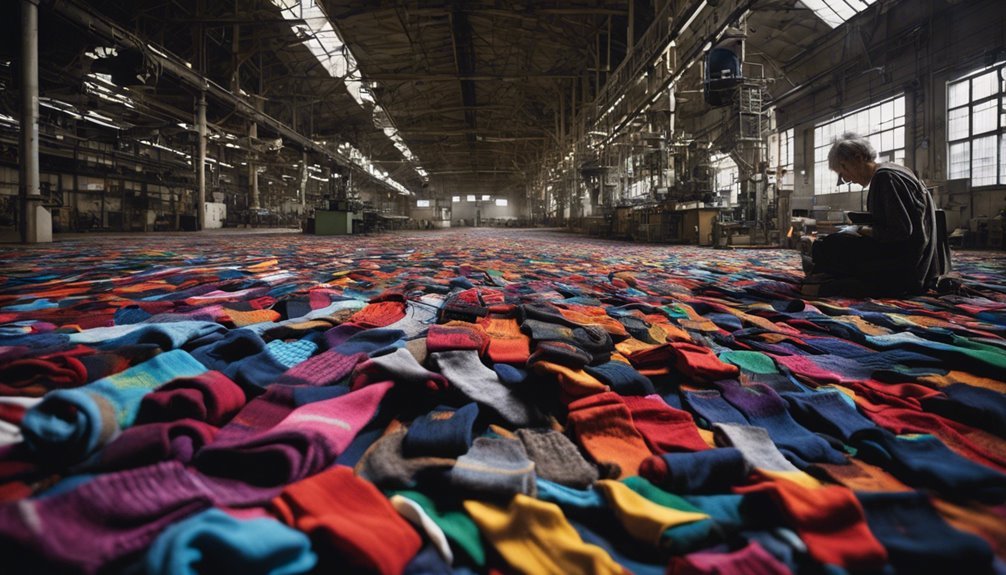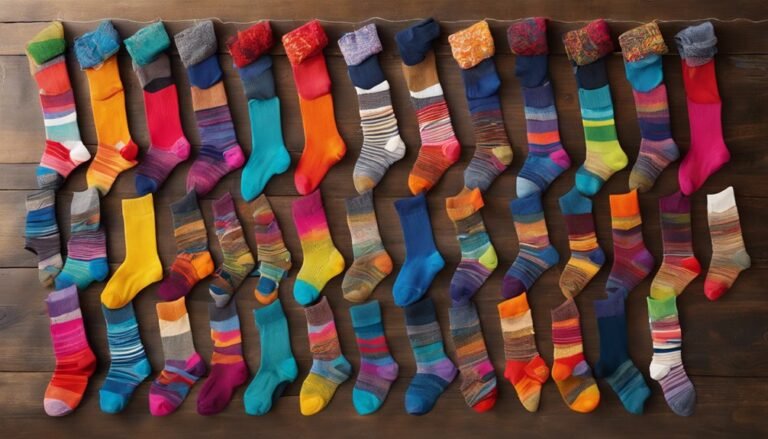The Impact of Fast Fashion on the Sock Industry
Fast fashion has drastically shifted your sock shopping habits. You tend to prioritize low-cost, trendy options, often sacrificing durability for immediate appeal. This rush towards quantity has led to increased waste, as cheaper materials result in shorter lifespans. Additionally, the industry faces ethical dilemmas, with many workers exploited under poor conditions. As sustainability becomes essential, consumers, like you, are waking up to these challenges and pushing for better practices. Discover what choices can align your sock purchases with your values.
The Rise of Fast Fashion and Its Influence on Consumer Behavior

As fast fashion continues to dominate the retail landscape, it's crucial to examine how it shapes consumer behavior, particularly when it comes to everyday items like socks. The rapid turnover of fashion cycles encourages you to chase trends, often leading to impulsive purchases. Data shows that consumers increasingly prioritize variety over quality, opting for cheaper socks that align with fleeting styles. This shift directly impacts consumer trends, where low-cost, high-volume strategies redefine your buying habits. You may find yourself buying multiple pairs in different colors to match outfits, sacrificing durability for the sake of novelty. As this phenomenon persists, it raises questions about sustainability and the long-term implications for both your wardrobe and the environment.
Understanding the Sock Market: A Historical Perspective
While many might consider socks a mundane wardrobe staple, their market has evolved considerably over time, reflecting broader societal changes and economic trends. Understanding historical trends is essential to grasping the current sock market's dynamics. Here are four key stages in this market evolution:
- Handcrafted Origins: Initially, socks were handmade, emphasizing craftsmanship.
- Industrial Revolution: The advent of machinery in the 19th century led to mass production, making socks more accessible.
- Fashion Integration: By the late 20th century, socks shifted from mere utility to fashion statements.
- Fast Fashion Era: Today, rapid production cycles dominate, emphasizing style over durability.
This journey shows how socks are not just functional but also reflect our changing values and consumer preferences.
Quality vs. Quantity: The Impact of Mass Production on Sock Durability
Although the allure of fast fashion has made trendy socks more accessible than ever, the focus on rapid production often compromises durability. Mass production methods prioritize quantity over quality, leading to socks that may look great but fall short in longevity. Studies show that cheaper, lower-quality materials and rushed manufacturing processes can result in a significant decline in sock lifespan. You might find yourself replacing worn-out pairs more frequently, undermining the initial savings. In contrast, investing in higher-quality socks, made with attention to craftsmanship, can enhance your wardrobe's sustainability and comfort. As you navigate the sock market, consider the long-term value of durability over the fleeting appeal of fast fashion. Your feet—and the planet—will thank you.
Labor Practices in the Sock Industry: A Closer Look

Despite the enticing prices of fast fashion socks, the labor practices behind their production often reveal a troubling reality. Many brands prioritize profit over ethical standards, resulting in widespread wage exploitation and violations of worker rights. Here are some key issues to reflect upon:
- Low Wages: Many sock factory workers earn less than a living wage.
- Long Hours: Workers often face excessive overtime without proper compensation.
- Unsafe Conditions: Factories may lack basic safety measures, putting workers at risk.
- Lack of Rights: Labor unions and workers' rights are frequently suppressed.
As you evaluate your sock choices, remember that every purchase can either support or challenge these unethical practices. Understanding the reality behind fast fashion can empower you to make more informed decisions.
Environmental Consequences of Sock Production
As the demand for fast fashion socks continues to rise, the environmental consequences of their production become increasingly alarming. The sock industry often relies on unsustainable materials and processes that contribute to pollution and waste. For instance, conventional cotton farming uses large amounts of water and harmful pesticides, while synthetic fibers can take centuries to decompose. By prioritizing sustainable materials and eco-friendly practices, you can reduce your environmental footprint. Brands adopting organic cotton or recycled fibers, along with minimizing waste through efficient production methods, are paving the way for a greener future. However, without a shift towards these practices, the ecological damage from fast fashion socks will only escalate, impacting our planet and future generations.
The Role of Synthetic Materials in Fast Fashion Socks
Synthetic materials play an important role in fast fashion socks, often chosen for their cost-effectiveness and ability to meet current trends. However, these materials can contribute greatly to environmental damage, as their production and disposal generate waste and pollution. As you consider your sock choices, it is vital to weigh the short-term benefits against the long-term implications of synthetic fabric usage.
Environmental Impact of Synthetics
While many consumers appreciate the affordability and variety of fast fashion socks, the environmental implications of synthetic materials used in their production cannot be overlooked. The reliance on synthetics contributes considerably to synthetic waste, which poses a threat to ecosystems. You might be surprised to learn about these impacts:
- Non-Biodegradability: Synthetic fibers can take hundreds of years to decompose.
- Microplastic Pollution: Washing these socks releases microplastics into waterways.
- Resource Intensity: Producing synthetics requires fossil fuels and water, straining resources.
- Lax Regulations: Many regions lack stringent environmental regulations, allowing unchecked waste.
As you consider your sock choices, it's essential to weigh these environmental costs against the benefits of fast fashion. Your decisions can influence a more sustainable future.
Cost-Effectiveness vs. Quality
When you consider the trade-offs between cost-effectiveness and quality in fast fashion socks, it's clear that synthetic materials play a pivotal role. These materials often yield significant cost benefits, making socks affordable for consumers. However, they also raise quality concerns regarding durability and comfort.
| Aspect | Cost-Effectiveness | Quality Concerns |
|---|---|---|
| Material | Low-cost synthetics | Prone to wear and tear |
| Production Speed | Rapid manufacturing processes | Inconsistent quality control |
| Consumer Demand | High turnover rates | Short-lived satisfaction |
| Environmental Impact | Lower production costs | Unfavorable long-term effects |
This dichotomy leaves consumers grappling with the allure of low prices, while also questioning the longevity and comfort of their choices.
Trends in Sock Materials
As the fast fashion industry continues to evolve, the choice of materials used in socks has shifted considerably, with synthetic fibers becoming increasingly dominant. These materials offer cost-effectiveness and versatility but raise concerns about sustainability.
To better understand this trend, consider these key factors:
- Durability: Synthetic fibers enhance the lifespan of socks, reducing waste.
- Cost-Effectiveness: They're cheaper to produce, appealing to fast fashion brands.
- Sock Innovations: Advances in technology lead to improved comfort and moisture-wicking properties.
- Sustainable Fibers: There's a growing push for eco-friendly alternatives, signaling a shift toward sustainability.
As you explore your sock choices, consider the impact of these materials on both your comfort and the environment.
Brands Committed to Sustainability in the Sock Industry

The rise of sustainability in the sock industry reflects a growing consumer demand for eco-friendly products. Brands like Bombas and Conscious Step are leading the charge by using sustainable materials such as organic cotton and recycled fibers. These companies prioritize ethical production practices, ensuring fair labor conditions and minimal environmental impact. Data shows that consumers are willing to pay a premium for socks made from eco-conscious materials, indicating a shift in purchasing behavior. Additionally, studies suggest that sustainable brands can enhance customer loyalty, as shoppers increasingly seek to align their values with their purchases. By choosing brands committed to sustainability, you're not just buying socks; you're supporting a movement towards responsible consumption and a healthier planet.
Consumer Awareness: The Shift Towards Ethical Sock Choices
With rising awareness about the environmental and ethical implications of consumer choices, many shoppers are now prioritizing sustainable options in their sock purchases. This shift is largely driven by consumer education and a growing demand for transparency. As a result, ethical brands are gaining popularity among conscious consumers.
Here are four key factors influencing this trend:
- Sustainable Materials: Consumers are opting for organic cotton and recycled fibers.
- Fair Labor Practices: Many seek brands committed to ethical labor conditions.
- Transparency: Shoppers appreciate clear information about sourcing and production.
- Environmental Impact: Awareness of waste and pollution drives the choice for eco-friendly options.
This conscious consumerism leads to a more responsible sock industry, empowering you to make choices that align with your values.
The Future of Sock Production: Innovations and Challenges
While many consumers are shifting towards ethical sock choices, the future of sock production faces both exciting innovations and significant challenges. Sustainable technologies are revolutionizing the industry, pushing manufacturers to adopt processes that minimize environmental impact. For instance, advancements in recycling methods and the use of biodegradable materials could reshape how socks are produced. Additionally, innovative fabrics, such as those made from organic cotton or recycled polyester, are gaining traction, offering consumers both comfort and durability. However, these shifts require substantial investment and a re-evaluation of supply chains. As you explore your options, consider how these innovations might align with your values, but remain aware of the complexities that manufacturers face in balancing sustainability with consumer demand.
How to Make Sustainable Sock Choices as a Consumer
How can you guarantee your sock purchases align with sustainable practices? By making informed choices, you can embrace conscious shopping while supporting ethical materials. Here's how:
- Research Brands: Look for companies committed to sustainability and transparency in their supply chains.
- Choose Organic Fabrics: Opt for socks made from organic cotton, bamboo, or recycled materials that minimize environmental impact.
- Prioritize Durability: Select high-quality options that last longer, reducing the need for frequent replacements.
- Support Local: Buy from local artisans or small businesses that prioritize ethical production over mass manufacturing.
Frequently Asked Questions
What Materials Are Commonly Used in Fast Fashion Socks?
When you explore fast fashion socks, you'll find a tapestry woven from synthetic fibers and, occasionally, sustainable materials. These choices often reflect a fleeting trend, prioritizing cost over quality, leaving eco-conscious consumers yearning for more.
How Do Sock Trends Change With Fast Fashion Cycles?
Sock trends shift rapidly with fast fashion cycles, as brands introduce new sock colorways and seasonal patterns. You'll notice how quickly styles change, reflecting broader fashion trends and consumer desires for fresh, expressive designs.
Are There Specific Fast Fashion Brands Dominating the Sock Market?
Imagine maneuvering a crowded marketplace; fast fashion brands like H&M and Zara dominate, creating fierce brand competition. Yet, many consumers crave sock sustainability, seeking eco-friendly alternatives amidst the chaos of ever-changing trends.
How Has Online Shopping Influenced Sock Purchasing Habits?
Online sock shopping's made it easier for you to explore diverse brands and styles. With just a click, consumer purchasing habits have shifted towards convenience and variety, allowing you to express your individuality effortlessly.
What Are the Most Popular Sock Styles in Fast Fashion?
You'll find that trendy patterns dominate fast fashion sock styles. However, many consumers are shifting towards sustainable alternatives, seeking unique designs that reflect personal values while maintaining style, ultimately driving change in the market's dynamics.







